Experimental Study on the Agglomeration of Oily Fine Particles by Sound Wave
Abstract
:1. Introduction
2. Materials and Methods
2.1. Experimental Equipment and Apparatus
2.2. Design of the Experimental Platform
2.3. Experimental Process
2.3.1. Oily Fine Particle Test Procedure
2.3.2. Non-Oily Fine Particle Test Procedure
2.4. Evaluation Index
3. Results and Discussion
3.1. Comparison of Oil-Based and Non-Oil-Based
3.2. Effect of Initial Concentration Contrast
3.3. Influence of Reunion Time
3.4. Effect of the Number of Oscillators
3.5. Aggregation Holding Time after the Oscillator Is Turned Off
4. Conclusions
Author Contributions
Funding
Data Availability Statement
Conflicts of Interest
References
- Chen, M.R.; Tsai, P.-J.; Chang, C.C.; Shih, T.S.; Lee, W.L.; Liao, P.-C. Particle size distributions of oil mists in workplace atmospheres and their exposure concentrations to workers in a fastener manufacturing industry. J. Hazard. Mater. 2007, 146, 393–398. [Google Scholar] [CrossRef]
- Chen, M.R.; Tsai, P.-J.; Wang, Y.-F. Assessing inhalatory and dermal exposures and their resultant health-risks for workers exposed to polycyclic aromatic hydrocarbons (PAHs) contained in oil mists in a fastener manufacturing industry. Environ. Int. 2008, 34, 971–975. [Google Scholar] [CrossRef]
- Iwasaki, M.; Hirai, K.; Fukumori, K.; Higashi, H.; Inomata, Y.; Seto, T. Characterization of Submicron Oil Mist Particles Generated by Metal Machining Processes. Aerosol Air Qual. Res. 2020, 20, 1469–1479. [Google Scholar] [CrossRef] [Green Version]
- Wang, X.; Zhou, Y.; Wang, F.; Jiang, X.; Yang, Y. Exposure levels of oil mist particles under different ventilation strategies in industrial workshops. Build. Environ. 2021, 206, 108264. [Google Scholar] [CrossRef]
- Brandt, O.; Hiedemann, E.A. The aggregation of suspended particles in gases by sonic and supersonic waves. Trans. Faraday Soc. 1936, 32, 1101–1110. [Google Scholar] [CrossRef]
- Dodemand, E.; Prud’homme, R.; Kuentzmann, P. Influence of unsteady forces acting on a particle in a suspension application to the sound propagation. Int. J. Multiph. Flow 1995, 21, 27–51. [Google Scholar] [CrossRef]
- Mednikov, E.P.; Larrick, C.V. Acoustic Coagulation and Precipitation of Aerosols; USSR Academy of Sciences Press: Moscow, Russia, 1965. [Google Scholar]
- Kumari, S.; Kumar, R.N. River water treatment by continuous electrocoagulation: Insights into removal of Acetaminophen, and natural organic matter. Water Supply 2022, 22, 4055–4066. [Google Scholar] [CrossRef]
- Wang, J.; Li, Z.; Jia, Y.; Wang, B.-B.; Xu, Z. Molecular dynamics simulation of effect of temperature on Cu nanoparticles agglomeration of nanofluids. J. Nanopart. Res. 2021, 23, 28. [Google Scholar] [CrossRef]
- Kim, H. Analysis of Agglomeration Kinetics of Magnetic Nanoparticles with Boltzmann Distribution of Energy Barrier. Bull. Korean Chem. Soc. 2021, 42, 973–976. [Google Scholar] [CrossRef]
- Lin, C.; Zhang, G.; Ma, Z.; Wang, J.; Gu, H.; Yuan, D. Research on the Microscopic Mechanism of Sound Wave Agglomeration of Fine Particles. Acoust. Technol. 2021, 40, 587–593. [Google Scholar]
- Cleckler, J.; Elghobashi, S.E.; Liu, F. On the motion of inertial particles by sound waves. Phys. Fluids 2012, 24, 033301. [Google Scholar] [CrossRef] [Green Version]
- Song, X.; Fan, F. Analysis of Factors Influencing the Drift of Inhalable Particles in Standing Wave Sound Fields. Therm. Power Eng. 2016, 31, 81–86+135–136. [Google Scholar]
- Prince, B.; Zhong, X.; Yan, Y.; Ge, R. PM in the Sound Field_(2.5) Particle collision motion model. J. Environ. Eng. 2011, 5, 2839–2843. [Google Scholar]
- Shaw, D.T.; Tu, K.-w. Acoustic particle agglomeration due to hydrodynamic interaction between monodisperse aerosols. J. Aerosol Sci. 1979, 10, 317–328. [Google Scholar] [CrossRef]
- Sv, P.-S. Aggregation of aerosol particles in a sound field under the influence of the Oseen hydrodynamic forces. Dokl. Akad. Nauk SSSR 1959, 125, 775–778. [Google Scholar]
- Shirokov, O.É.N.L. Interaction of aerosol particles in an acoustic field. Sov. Phys. Acoust. 1966, 11, 346–348. [Google Scholar]
- Dianov, A.A.P.D.B.; Turubarov, V.I. Calculation of the hydrodynamic interaction of aerosol particles in a sound field under seen flow conditions. Sov. Phys. Acoust. 1968, 13, 314–319. [Google Scholar]
- González, I.; Hoffmann, T.L.; Gallego, J.A. Precise Measurements of Particle Entrainment in a Standing-Wave Acoustic Field between 20 and 3500 Hz. J. Aerosol Sci. 2000, 31, 1461–1468. [Google Scholar] [CrossRef]
- Maknickas, A.; Markauskas, D.; Kačianauskas, R. Discrete element simulating the hydrodynamic effects in acoustic agglomeration of micron-sized particles. Part. Sci. Technol. 2016, 34, 453–460. [Google Scholar] [CrossRef]
- Markauskas, D.; Kačianauskas, R.; Maknickas, A. Numerical particle-based analysis of the effects responsible for acoustic particle agglomeration. Adv. Powder Technol. 2015, 26, 698–704. [Google Scholar] [CrossRef]
- Zhang, G.; Liu, J.; Wang, J.; Zhou, J.; Cen, K. Numerical simulation of acoustic wake effect in acoustic agglomeration under Oseen flow condition. Chin. Sci. Bull. 2012, 57, 2404–2412. [Google Scholar] [CrossRef] [Green Version]
- Zhang, G.; Liu, J.; Wang, J.; Zhou, J.; Cen, K. Theoretical research on wake effect in acoustic wave agglomeration. J. Chem. Eng. 2013, 27, 199–204. [Google Scholar]
- Zhang, G.X.; Zhang, L.; Wang, J.; Chi, Z. A new model for the acoustic wake effect in aerosol acoustic agglomeration processes. Appl. Math. Model. 2018, 61, 124–140. [Google Scholar] [CrossRef]
- Hoffmann, T.L.; Koopmann, G.H. Visualization of acoustic particle interaction and agglomeration: Theory and experiments. J. Acoust. Soc. Am. 1996, 99, 2130–2141. [Google Scholar] [CrossRef]
- Kang, Y.; Zhu, Y.; Lin, F.; Zhang, W. Factors affecting ultrasonic agglomeration of ultrafine particles. J. Shanghai Jiao Tong Univ. 2016, 50, 551–556. [Google Scholar]
- Zhou, D.; Luo, Z.-Y.; Fang, M.; Lu, M.; Jiang, J.; Chen, H.; He, M. Numerical calculation of particle movement in sound wave fields and experimental verification through high-speed photography. Appl. Energy 2017, 185, 2245–2250. [Google Scholar] [CrossRef]
- Li, K.; Wang, E.; Wang, Q.; Husnain, N.; Li, D.; Fareed, S. Improving the removal of inhalable particles by combining flue gas condensation and acoustic agglomeration. J. Clean. Prod. 2020, 261, 121270. [Google Scholar] [CrossRef]
- Biegert, E.; Vowinckel, B.; Meiburg, E. A collision model for grain-resolving simulations of flows over dense, mobile, polydisperse granular sediment beds. J. Comput. Phys. 2016, 340, 105–127. [Google Scholar] [CrossRef] [Green Version]
- Sun, D.; Guo, Q. Experimental study on sound field agglomeration of inhalable particles. Chem. Eng. 2010, 38, 81–84. [Google Scholar]






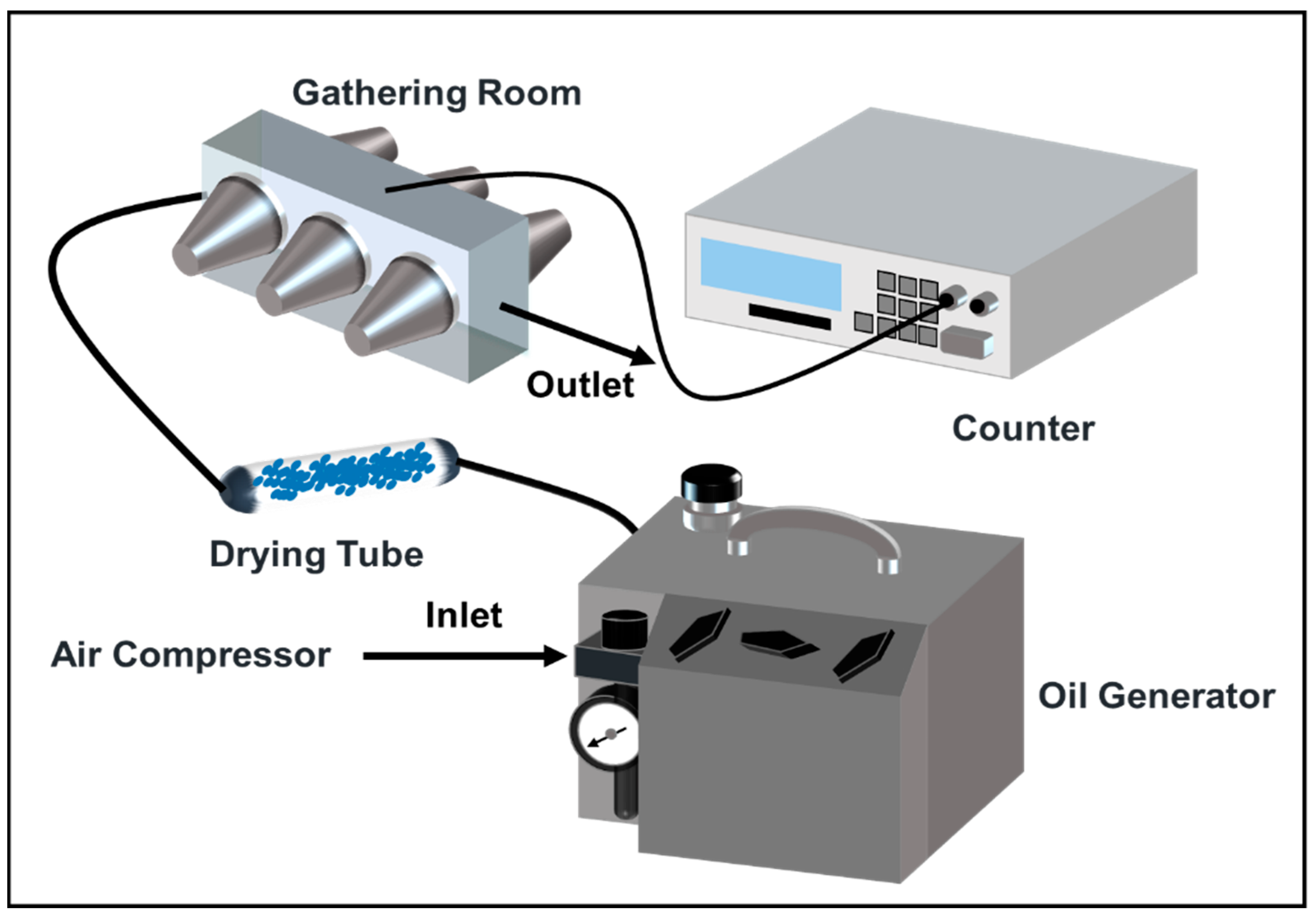
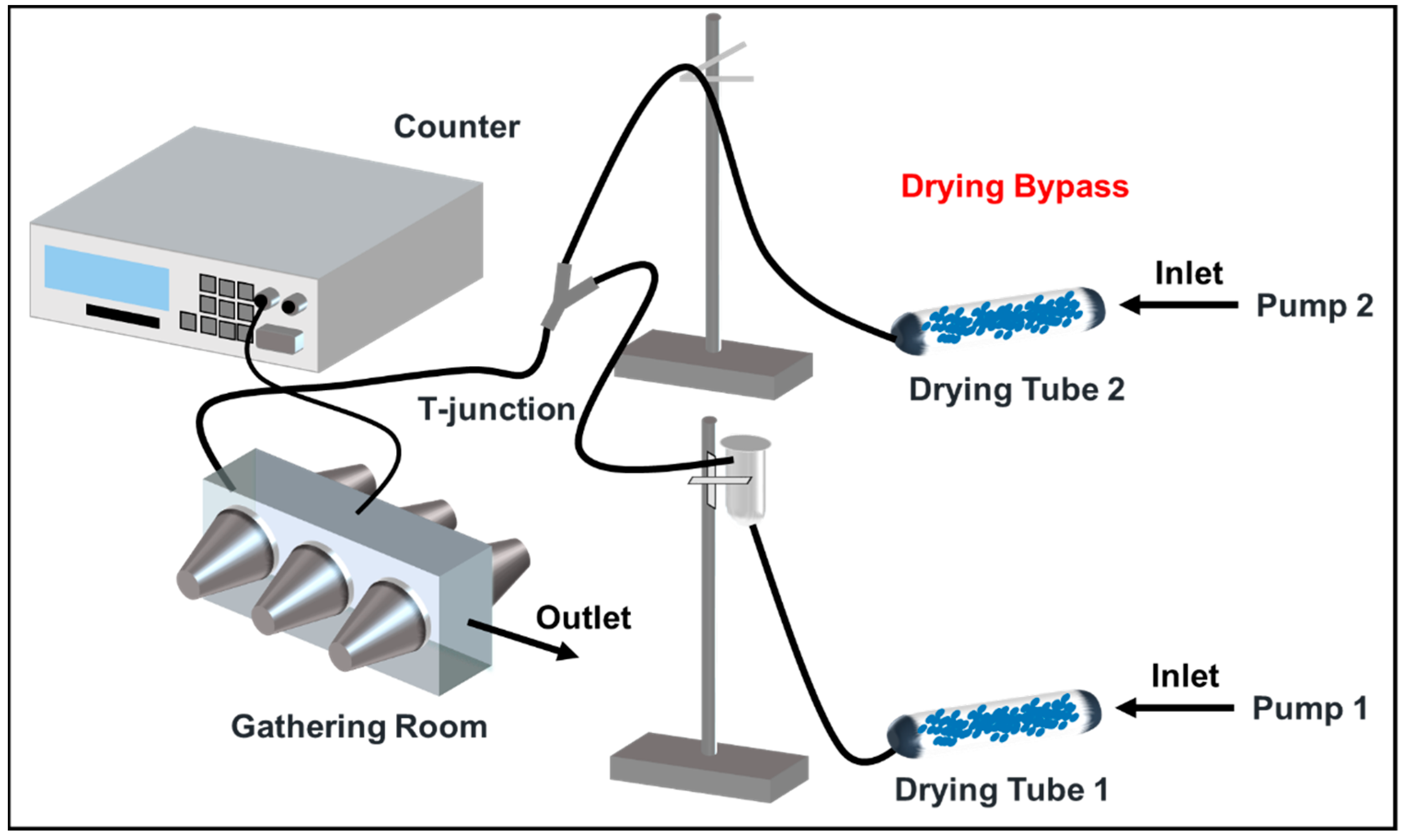




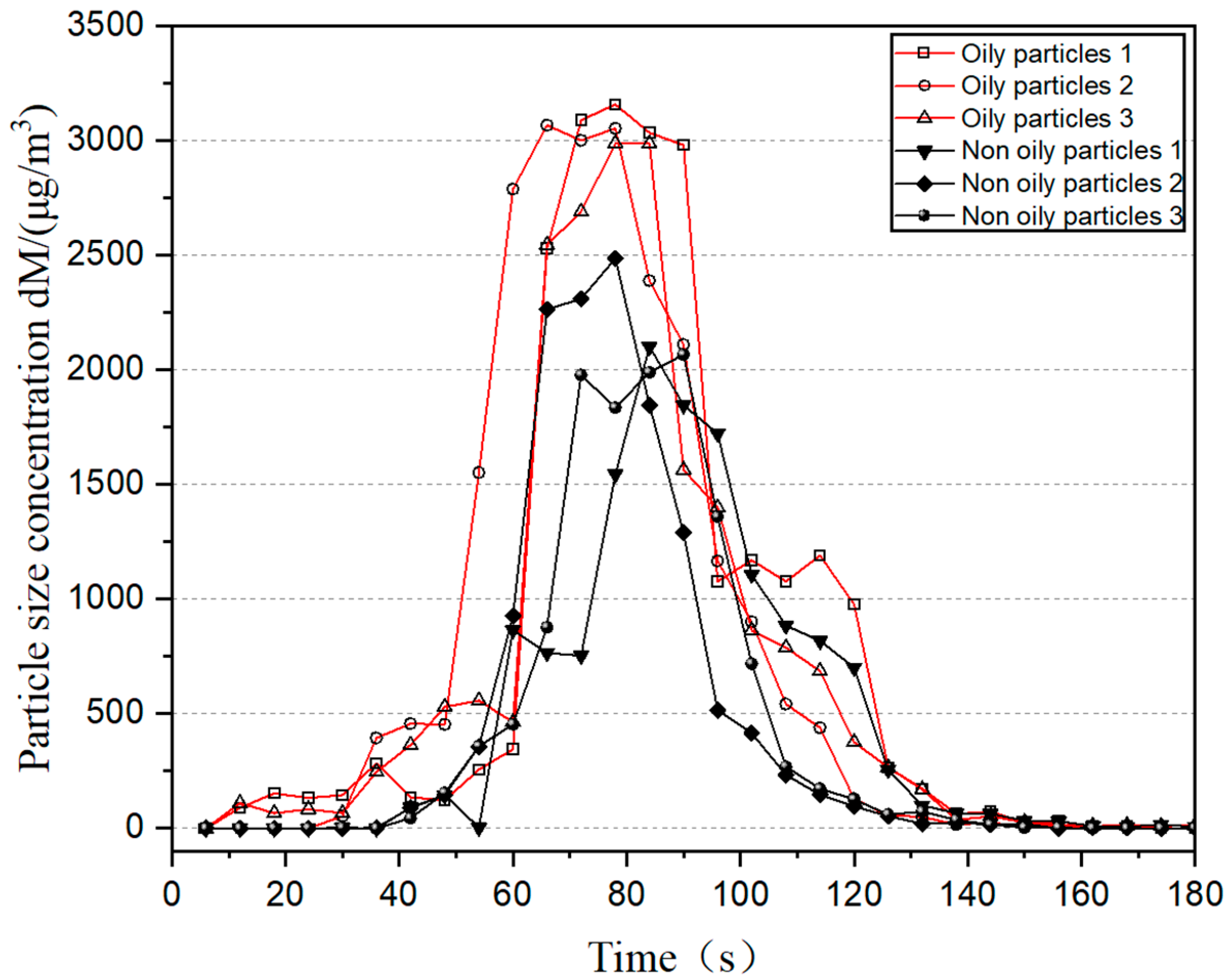
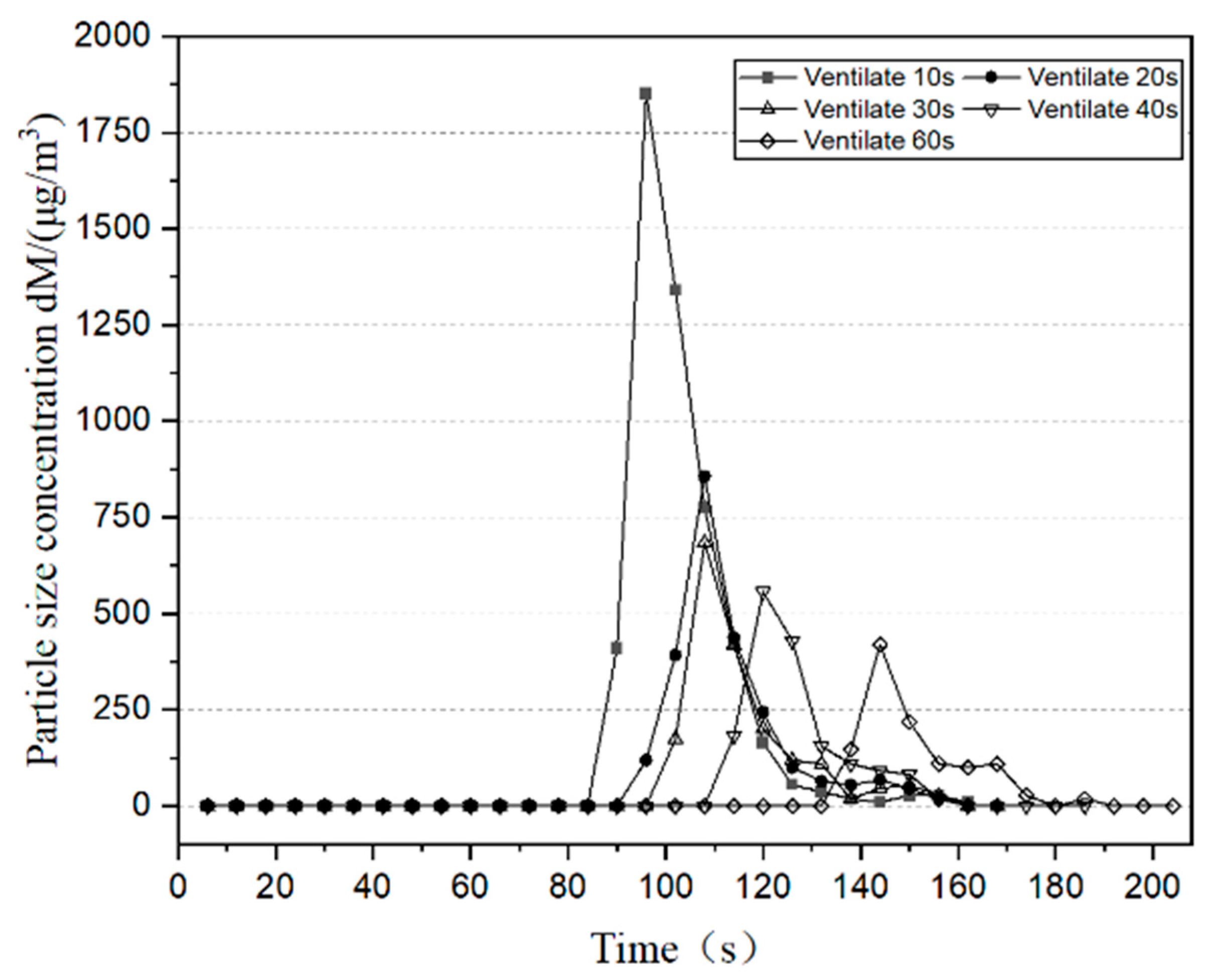

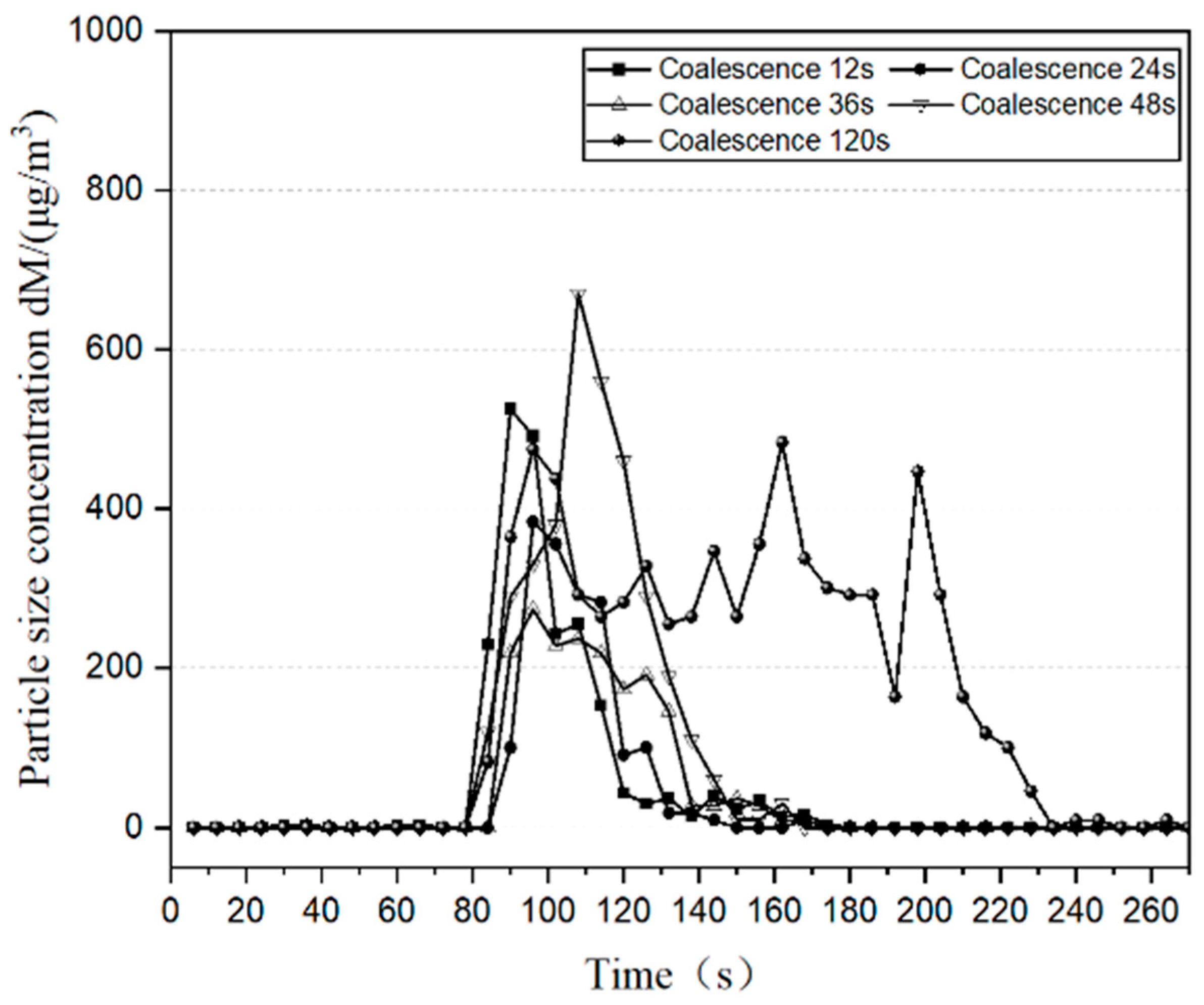

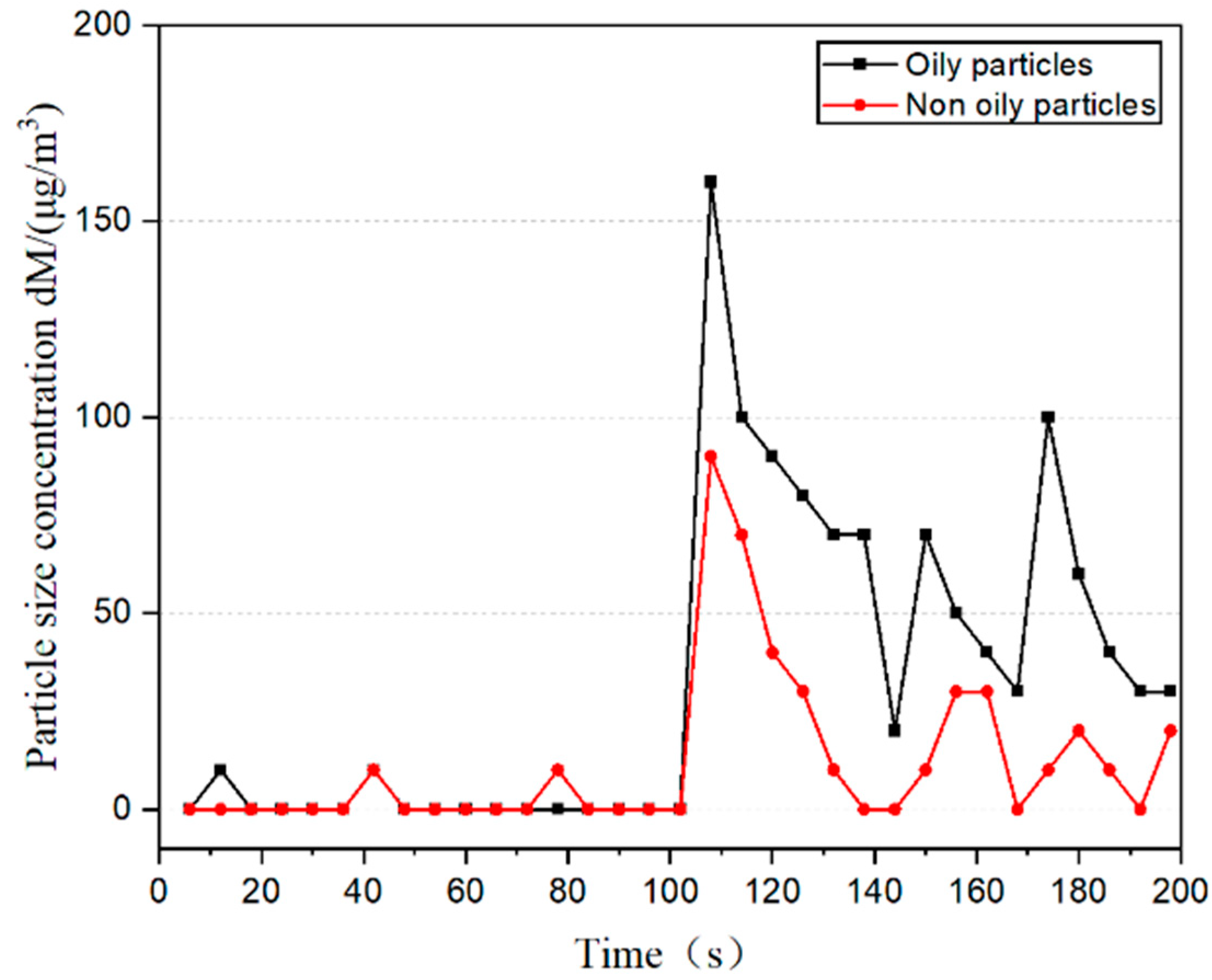
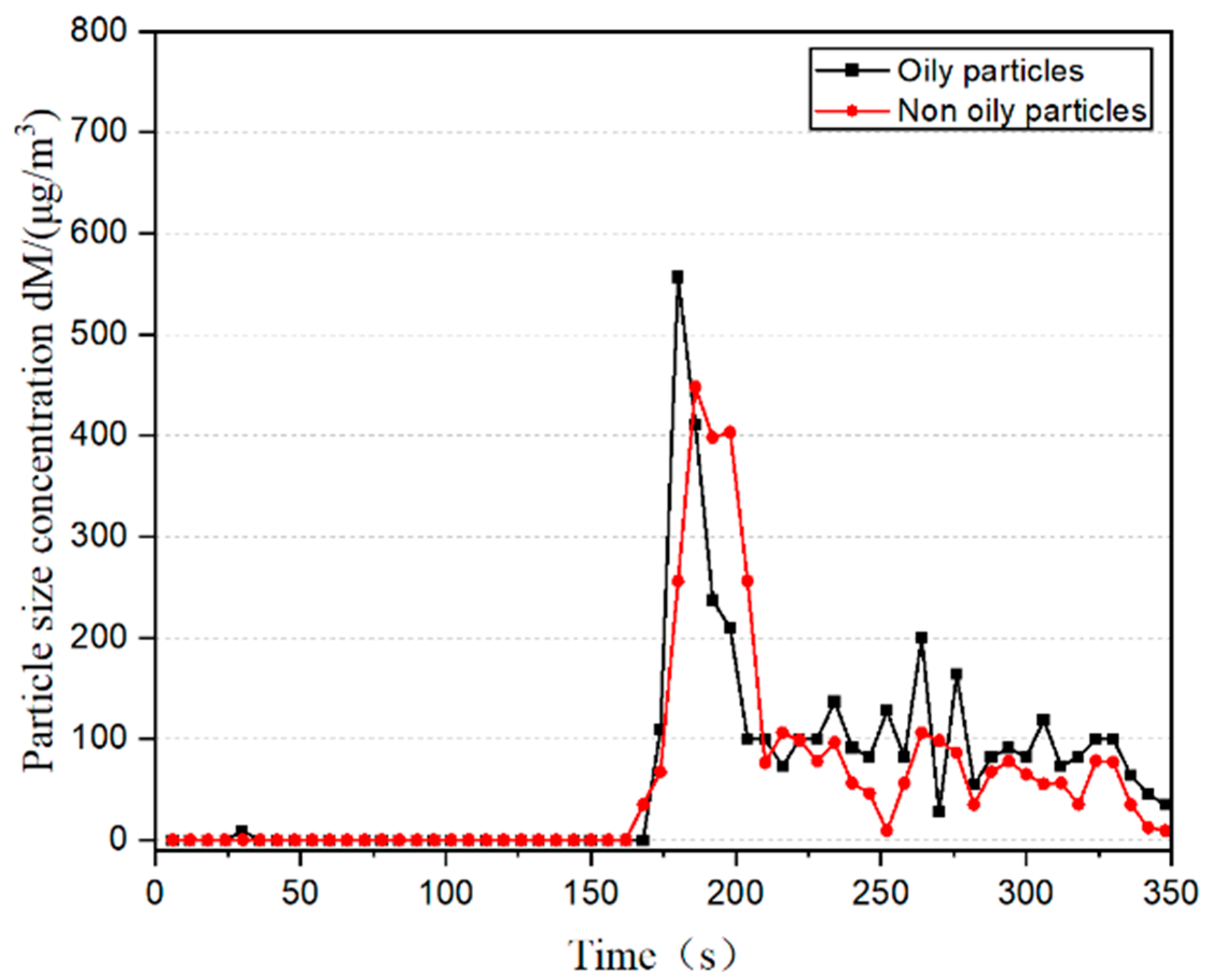

| Ventilation Time | 10 s | 20 s | 30 s | 40 s | 60 s |
|---|---|---|---|---|---|
| 1.31 | 1.27 | 1.19 | 1.18 | 1.28 |
| Reunion Time | 12 s | 24 s | 36 s | 48 s | 120 s |
|---|---|---|---|---|---|
| 1.26 | 1.20 | 1.31 | 1.18 | 1.10 |
Disclaimer/Publisher’s Note: The statements, opinions and data contained in all publications are solely those of the individual author(s) and contributor(s) and not of MDPI and/or the editor(s). MDPI and/or the editor(s) disclaim responsibility for any injury to people or property resulting from any ideas, methods, instructions or products referred to in the content. |
© 2023 by the authors. Licensee MDPI, Basel, Switzerland. This article is an open access article distributed under the terms and conditions of the Creative Commons Attribution (CC BY) license (https://creativecommons.org/licenses/by/4.0/).
Share and Cite
Wang, X.; Li, D.; Zhang, Q.; Li, T.; Cao, Z.; Wang, F. Experimental Study on the Agglomeration of Oily Fine Particles by Sound Wave. Buildings 2023, 13, 1660. https://doi.org/10.3390/buildings13071660
Wang X, Li D, Zhang Q, Li T, Cao Z, Wang F. Experimental Study on the Agglomeration of Oily Fine Particles by Sound Wave. Buildings. 2023; 13(7):1660. https://doi.org/10.3390/buildings13071660
Chicago/Turabian StyleWang, Xin, Dekang Li, Qi Zhang, Tian Li, Zhiyin Cao, and Fei Wang. 2023. "Experimental Study on the Agglomeration of Oily Fine Particles by Sound Wave" Buildings 13, no. 7: 1660. https://doi.org/10.3390/buildings13071660




